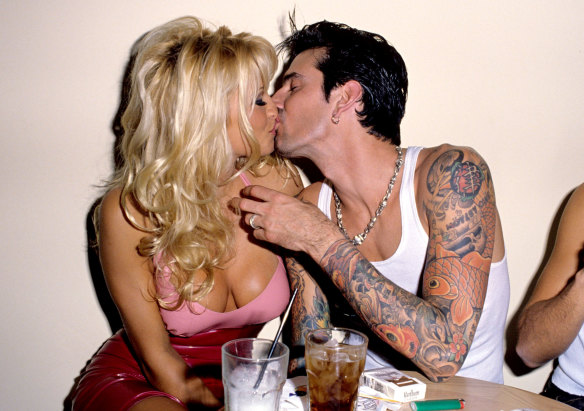This was published 2 years ago
How the celebrity sex tape has changed our sex lives
It’s a grainy recording of some of the most intimate moments a couple can share, yet it’s been loaded with all kinds of cultural significance. It’s been called everything from an event that is “etched into our collective subconscious” to “a defining artifact of the internet age”.
We’re talking, of course, about the Hi8 camcorder footage of Pamela Anderson and her then-husband, Tommy Lee, the drummer for heavy metal band Mötley Crüe, getting down to bedroom business on their honeymoon in 1995.

Leaked sex tapes featuring, from left, Pamela Anderson, Kim Kardashian and Paris Hilton have influenced what ordinary Australians are pressured to do in their bedrooms. Credit: Getty Images
The couple’s tape, never intended for public viewing, was stolen by a porn underling who was renovating the couple’s home and became one of the most clamoured-after videos of the 1990s. The bizarre details are now the focus of an eight-part documentary series, Pam and Tommy, on Disney+.
But what impact has the ongoing trend of the celebrity sex tape had on the intimate lives of ordinary Australians?
Anderson and Lee’s tape was just the beginning; the first of its kind, thanks to the internet, to go viral. And, since then, everyone from Kim Kardashian to Paris Hilton and Colin Farrell have had tapes of their most private moments released to the world.
Some sexuality experts say the trend has led countless people to feel inadequate or to feel pressured to engage in sex acts they aren’t comfortable with.
“Once the celebrity things [tapes] become more popular, the sex tape idea, I’ve seen clients feeling pressure that they should do something similar … [they] should be allowing their partner to film them during sexual activities,” says Dr Simone Buzwell, a sexual identity researcher at Swinburne University.
Buzwell’s clients, who have felt pressured by partners to film their intimate moments, were mostly women in heterosexual relationships.
“There is a lot of pressure on men, too, to always be extremely virile, and always up for sex, always wanting it,” says Buzwell. (Anderson and Lee’s sex tape led to Lee being hailed as the best-endowed man in Hollywood.) “I’ve had clients being told, ‘You’re not a man’, ‘You just don’t have sex with me as regularly as I want’.”
Several celebrity sex tapes were released without the individuals’ consent (Kim Kardashian has referred to the leak of her sex tape as “humiliating”) and this now plays out outside of Hollwood too. Sexually explicit material filmed or circulated without a participant’s consent is referred to as “image-based abuse”.

Pamela Anderson, pictured with then-husband Tommy Lee in Las Vegas in 1995, was asked by lawyers, “why I’d even care that the tape was out there”, given that she’d posed naked in Playboy, she said in Lee’s autobiography, Tommyland.Credit: Getty Images
The celebrity sex tape has also contributed, in part, to a rise in the last 5-10 years of women getting labiaplasty, a plastic surgery procedure that alters the folds of skin surrounding the vulva, says Dr Toni Pikoos, a psychologist who researches the outcomes of cosmetic procedures at Swinburne University.
“It’s leading to this disruptive view of what their vagina looks like,” she says of sex tapes and other types of pornography, noting that they leave some women feeling “unhappy with some aspect of the appearance of their vagina because they’ve seen the idealised images.”
Part of the problem, says Buzwell, is that women aren’t adequately taught about the wide variety of normalcy in female genitalia.
“Boys can look at each other in the toilets… so you see other penises, but girls, you don’t compare labias, so you don’t quite know what’s normal,” she says.
But the trend of people seeing celebrities naked isn’t wholly negative.
“It can open up conversations and start people talking about different things,” says Buzwell. Some couples, of course, will feel connected and aroused by filming themselves having sex, and they’ll engage in the activity with full consent. It’s only when people feel they need this to be sexually gratified that it becomes a problem, says Buzwell.
For some viewers, sex tapes – even though they were leaked – can have another positive effect.
“I think about Colin Farrell’s sex tape a lot,” wrote female journalist Kendra James in 2017 on Shondaland, the website of TV producer Shonda Rhimes. Farrell’s tape, recorded with his then-girlfriend, model Nicole Narain, and leaked in 2005, was among the few times that James had seen one of the men she’d fantasised about while in high school – white Hollywood heartthrobs – lust after a black woman.

Actor Colin Farrell’s sex tape was leaked in 2005.Credit: Invision
“I could see myself in this woman and imagine that I might be the object of someone’s affection in Hollywood,” wrote James, who is African American, adding that it made her sexual desires feel less bizarre. “Representation matters in the immediate present when you’re at an age when pop culture plays such a big part in shaping your self-image.”
And, says Alan McKee, a professor of digital media at University of Technology Sydney, while young people need to be taught about the implications of making their intimate videos publicly available – and that it’s abusive to share such videos without their partner’s consent – porn, including celebrity sex tapes, can be a vital tool for constructing one’s identity.
“I’m a gay man; in the 1970s there were no gay men and no sexual identity,” says McKee, explaining that gay men were largely excluded from popular culture in Scotland, where he grew up. “Porn was the only way I found out what it meant to be gay.“ (He recently co-wrote a book about the effects of pornography after 50 years of academic research.)
Buzwell thinks we need more conversations about how people’s sexual desires vary hugely.
“The thing is, with sexuality, we’re not very good at talking about these issues, so people don’t know what’s normal,” says Buzwell. “So once they [people] start finding out, ‘Oh OK, so X does Y’, they start thinking, ‘That’s what I’m supposed to do’. Because we don’t have an idea.”
Make the most of your health, relationships, fitness and nutrition with our Live Well newsletter. Get it in your inbox every Monday.